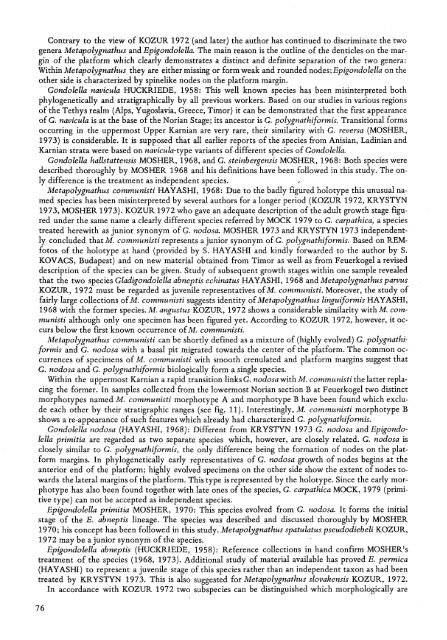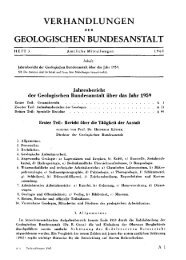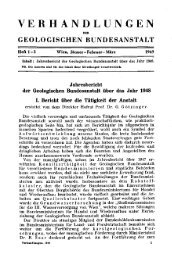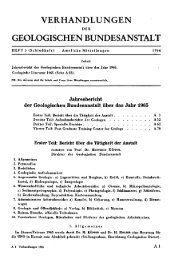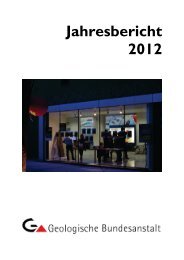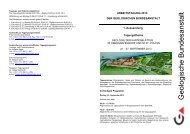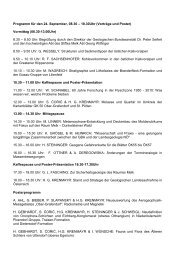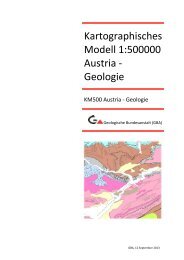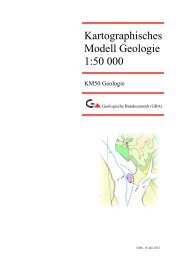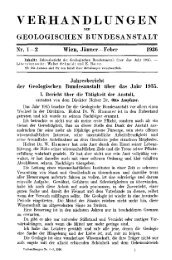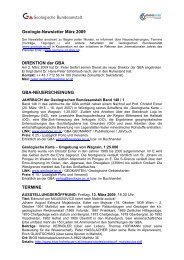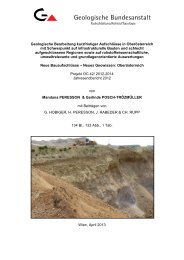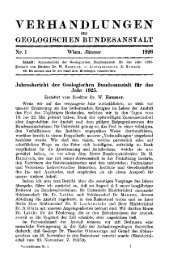Field Trip B TRIASSIC CONODONT LOCALITIES OF THE ...
Field Trip B TRIASSIC CONODONT LOCALITIES OF THE ...
Field Trip B TRIASSIC CONODONT LOCALITIES OF THE ...
You also want an ePaper? Increase the reach of your titles
YUMPU automatically turns print PDFs into web optimized ePapers that Google loves.
Contrary to the view of KOZUR 1972 (and later) the author has continued to discriminate the two<br />
genera Metapolygnathus and Epigondolella. The main reason is the outline of the denticles on the margin<br />
of the platform which clearly demonstrates a distinct and definite separation of the two genera:<br />
Within Metapolygnathus they are either missing or form weak and rounded nodes; Epigondolella on the<br />
other side is characterized by spinelike nodes on the platform margin.<br />
Gondolella navicula HUCKRIEDE, 1958: This well known species has been misinterpreted both<br />
phylogenetically and stratigraphically by all previous workers. Based on our studies in various regions<br />
of the Tethys realm (Alps, Yugoslavia, Greece, Timor) it can be demonstrated that the first appearance<br />
of G. navicula is at the base of the Norian Stage; its ancestor is G. polygnathiformis. Transitional forms<br />
occurring in the uppermost Upper Karnian are very rare, their similarity with G. reversa (MOSHER,<br />
1973) is considerable. It is supposed that all earlier reports of the species from Anisian, Ladinian and<br />
Karnian strata were based on navicula-type variants of different species of Gondolella.<br />
Gondolella hallstattensis MOSHER, 1968, and G. steinbergensis MOSHER, 1968: Both species were<br />
described thoroughly by MOSHER 1968 and his definitions have been followed in this study. The only<br />
difference is the treatment as independent species.<br />
Metapolygnathus communisti HAYASHI, 1968: Due to the badly figured holotype this unusual named<br />
species has been misinterpreted by several authors for a longer period (KOZUR 1972, KRYSTYN<br />
1973, MOSHER 1973). KOZUR 1972 who gave an adequate description of the adult growth stage figured<br />
under the same name a clearly different species referred by MOCK 1979 to G. carpathica, a species<br />
treated herewith as junior synonym of G. nodosa. MOSHER 1973 and KRYSTYN 1973 independently<br />
concluded thatM. communisti represents a junior synonym of G. polygnathiformis. Based on REMfotos<br />
of the holotype at hand (provided by S. HAYASHI and kindly forwarded to the author by S.<br />
KOVACS, Budapest) and on new material obtained from Timor as well as from Feuerkogel a revised<br />
description of the species can be given. Study of subsequent growth stages within one sample revealed<br />
that the two species Gladigondolella ahneptis echinatus HAYASHI, 1968 and Metapolygnathus parvus<br />
KOZUR, 1972 must be regarded as juvenile representatives of M. communisti. Moreover, the study of<br />
fairly large collections of M. communisti suggests identity of Metapolygnathus linguiformis HAYASHI,<br />
1968 with the former species. M. angustus KOZUR, 1972 shows a considerable similarity withM. communisti<br />
although only one specimen has been figured yet. According to KOZUR 1972, however, it occurs<br />
below the first known occurrence of M. communisti.<br />
Metapolygnathus communisti can be shortly defined as a mixture of (highly evolved) G. polygnathiformis<br />
and G. nodosa with a basal pit migrated towards the center of the platform. The common occurrences<br />
of specimens of M. communisti with smooth crenulated and platform margins suggest that<br />
G. nodosa and G. polygnathiformis biologically form a single species.<br />
Within the uppermost Karnian a rapid transition links G. nodosa with M. communisti the latter replacing<br />
the former. In samples collected from the lowermost Norian section B at Feuerkogel two distinct<br />
morphotypes named M. communisti morphotype A and morphotype B have been found which exclude<br />
each other by their stratigraphic ranges (see fig. 11). Interestingly, M. communisti morphotype B<br />
shows a re-appearance of such features which already had characterized G. polygnathiformis.<br />
Gondolella nodosa (HAYASHI, 1968): Different from KRYSTYN 1973 G. nodosa and Epigondolella<br />
primitia are regarded as two separate species which, however, are closely related. G. nodosa is<br />
closely similar to G. polygnathiformis, the only difference being the formation of nodes on the platform<br />
margins. In phylogenetically early representatives of G. nodosa growth of nodes begins at the<br />
anterior end of the platform; highly evolved specimens on the other side show the extent of nodes towards<br />
the lateral margins of the platform. This type is represented by the holotype. Since the early morphotype<br />
has also been found together with late ones of the species, G. carpathica MOCK, 1979 (primitive<br />
type) can not be accepted as independent species.<br />
Epigondolella primitia MOSHER, 1970: This species evolved from G. nodosa. It forms the initial<br />
stage of the E. ahneptis lineage. The species was described and discussed thoroughly by MOSHER<br />
1970; his concept has been followed in this study. Metapolygnathus spatulatus pseudodiebeli KOZUR,<br />
1972 may be a junior synonym of the species.<br />
Epigondolella ahneptis (HUCKRIEDE, 1958): Reference collections in hand confirm MOSHER's<br />
treatment of the species (1968, 1973). Additional study of material available has proved E. permica<br />
(HAYASHI) to represent a juvenile stage of this species rather than an independent taxon as had been<br />
treated by KRYSTYN 1973. This is also suggested for Metapolygnathus slovakensis KOZUR, 1972.<br />
In accordance with KOZUR 1972 two subspecies can be distinguished which morphologically are<br />
76


